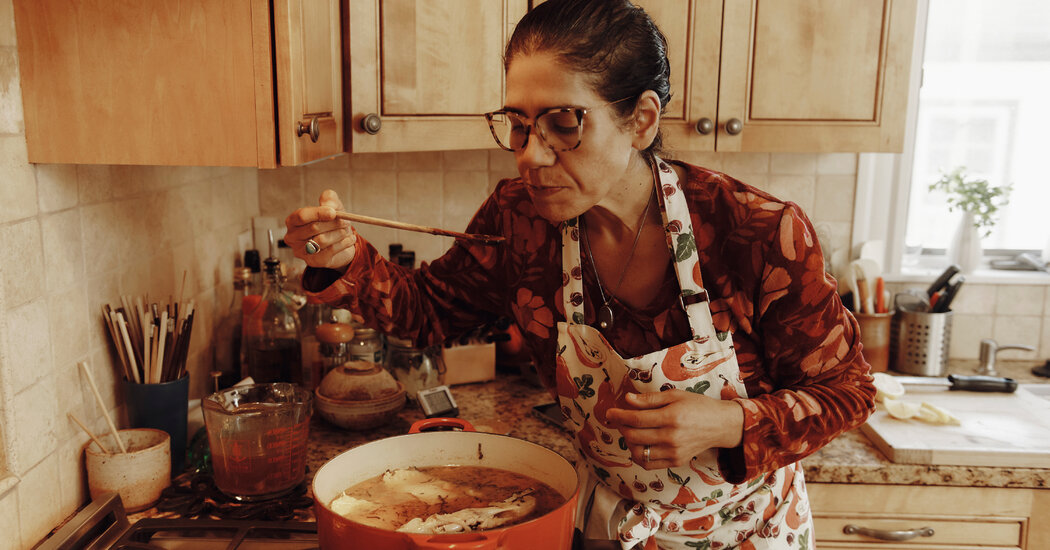
For Gail Jennings and her family, the Thanksgiving menu is never written in ink. One year, the turkey may appear on the table in her Durham, N.C., home burnished and whole, a Norman Rockwell painting come to life. The next, it may be roasted in parts, the drumsticks, wings and thighs swathed with onions and tomatoes. She might serve the traditional cornbread dressing, sweet potato casserole and macaroni and cheese, or maybe she’ll go with their veganized cousins, all depending on the particular diets her grandchildren are following that year.
“My grandkids go through phases,” Ms. Jennings said. “I just have to keep up with them.”
The day after Thanksgiving, however, is another matter. Every year without fail, Ms. Jennings gathers the leftover turkey to make a breathtakingly fiery gumbo.
When it comes to upcycling the remnants of Thanksgiving into leftovers soup, she is not alone. All over the country — sometimes even before the table is cleared and the dishes are put away — big pots are filled with turkey carcasses, scraps of skin, bits of meat, even the dregs of the gravy — and set to simmer on stovetops, in pressure cookers and in slow cookers. For legions of cooks, Thanksgiving isn’t complete without that final cauldron of leftovers soup, enough to last through the holiday weekend and into the next week.
As for what exactly goes into these fragrant pots, the possibilities are thrillingly disparate. Just as Thanksgiving varies widely from state to state and year to year, so does the next day’s soup.
Ms. Jennings makes hers from chunks of leftover turkey meat, the drippings and vegetables at the bottom of the roasting pan, chicken wings, shrimp, collard greens and a turkey bone or two to make the broth taste even richer.
To season it, she combines curry powder with King’s Pepper, a chile-and-herb blend of her own creation that’s based on a West African recipe. Then she ladles the steaming soup over mounds of fluffy white rice. It’s a staple on their table from Thanksgiving through Kwanzaa.
“You know regular gumbo?” Ms. Jennings asked. “This is gumbo’s daddy. It’s even better.”
A few hundred miles due north in Arlington, Mass., the leftover soup bubbling away in Cristiana N. de Carvalho’s pot is about as different from Ms. Jennings’s as can be considering that the main ingredient is still turkey. Instead of intensely peppery, it’s mellow and herbal, with a clear, velvety broth thickened with nubby pearled barley.
Having grown up in Brazil, Ms. de Carvalho didn’t celebrate Thanksgiving until she came to the United States in her 20s. When she saw the traditional roast turkeys on every American table, she was reminded of the birds her mother used to roast for Christmas in Rio de Janeiro.
“My mom always knew to marinate the turkey with herbs, and olive oil and salt,” Ms. de Carvalho said. The huge bird would take up almost the whole fridge for a few days, during which her mother would regularly flip it in its marinade before finally roasting it on Christmas Eve.
“When I came here and heard about brining,” Ms. de Carvalho said, “it made me think of my mother’s big turkey marinating in the fridge.”
Ms. de Carvalho’s mother, a Julia Child disciple and excellent cook, taught her daughter to make her own stocks from scratch out of carcasses, bones, fish heads, shrimp shells, and vegetables. But Ms. de Carvalho says store-bought broth works perfectly well in this soup.
“With soup, anyone can just chop up a few vegetables and add them to the pot with leftovers,” she said. “You don’t even need broth. Soup should be easy.”
This point is not lost on Liyan Chen of Montclair, N.J. She skips the stock entirely for her Thanksgiving leftover congee and uses water as the base, letting the fatty skin and the dark meat from the roasted bird flavor the soft, starchy rice.
The big difference in her home is that, instead of turkey, the bird at the center of her Thanksgiving table is a crisp-skinned roast duck.
“I’m not a big fan of turkey,” she explained.
Her congee recipe is based on what her family made regularly when she was growing up in Southern China. She combines jasmine rice, chopped roast duck (or any other leftover roasted meat) with water, salt and white pepper, then cooks it all in an electric pressure cooker for about half an hour until the rice starts to dissolve, thickening the mixture into a silky, mild porridge.
“For my family, congee is like comfort food, a bit like chicken soup is in American culture,” she said. “It’s what you want when you’re sick or tired, or if it’s a rainy day.”
Although she prefers to keep the seasonings on the plain side, Ms. Chen encourages people to add garnishes as they like — chopped romaine for texture, slivers of ginger, green onion, a little more white pepper or a drizzle of soy sauce. Heat seekers can spoon on chile oil or chile crisp to zip things up.



